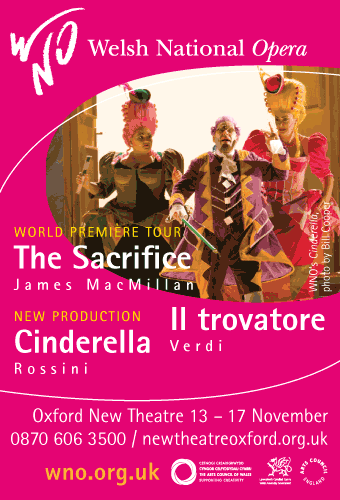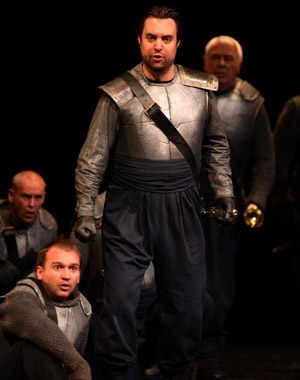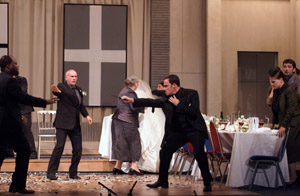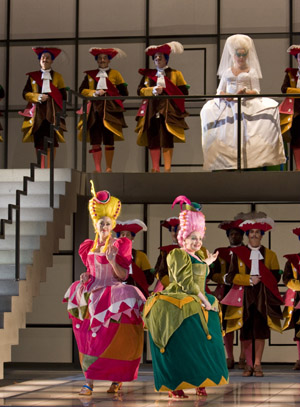The overture starts up. Immediately the audience are plunged into the flowery frills of Rossini's music. This is luxuriously the only time there is nothing else to concentrate on! It's light, and frothy, and frivolous, and we all prepare to be charmed.
Everyone knows the story of Cinderella, and the operatic plot is still very recognisable from Perrault's classic. The Fairy Godmother has become instead Alidoro, philosopher and tutor to Prince Ramiro, as Rossini did not want magic in his version. (WNO have not taken this lying down, however, and have put back as much as they can get away with! In a brilliant use of lighting Alidoro's shadow is projected large on the wall behind him, as he transforms Cinderella ready for the ball.) The other main deviation is that Prince Ramiro and his valet swap places, so the prince can find someone who loves him for himself. This creates a nice symmetry of the sudden changes in fortune - with Dandini the valet demoted again as suddenly as Cinderella is raised up the social ladder. And there's no slipper, apparently for reasons of Italian modesty, which is a great shame given the fabulous costuming!
The colours in this production are gaudy and sumptuous, and are used to reflect the difference between Cinderella and her morally corrupt family, and also between dreams and reality. Stepfather Don Magnifico's crumbling palace is grey and unsurprisingly ashen, and for the Palace the same scenery becomes a light box. The set and lighting are very well crafted - simple (mostly!) and very versatile. The chest of drawers becomes a carriage, the mirror scenery has a splendid double use which I won't reveal, and the Prince's fantastical horse becomes a throne.
Possibly the best device in the whole production is the team of rats. Much use is made of them, and they're so much fun they upstage everyone else, even earning themselves a round of applause during someone else's aria! They shift scenery, they drive the prince's carriage, and they bring about much of the magical change. They manage to be entirely credible as a largely invisible but ever-present troupe, and in doing so are a useful plot device in addition to their practical aspects: only Cinderella and Alidoro the wise see them for what they are, and they mark another boundary between dreams and reality. And of course they are not taken in by high rank, running amok just as happily in the palace as they do among the cinders.
The singing is really good. Cinderella (Marianna Pizzolato) in particular displays both lyricism and vocal dexterity in her leaps and ornamentations which mark out her performance as spellbinding. All the main characters sing richly and suit their parts perfectly. There are many ensemble pieces but the sextet "Questo è un nodo avviluppato" (something like "What a tangled knot we're in") with its rattling consonants and canonical structure was gripping.
There are various holes one could pick - there's a fair bit of repetitive action, notably in the tussling between Cinderella and Don Magnifico which happpens several times at the side of the stage. It doesn't go anywhere, but this is probably Rossini's fault as much as anyone else's! There are a couple of other places in which the production seems at odds with itself, inclusion of magic being one, visuals overshadowing music (the rats vs the aria), and Cinderella's character a third. She pleads passionately in Act 1 and yet appears so virtuous and submissive in Act 2 it's positively sickening. Again this is Rossini's choice, but doesn't sit so well in modern times where we're used to individual spirited heroines rather than the stock characters of the Comedia dell'arte. WNO then superimpose a much more satisfying ending, which again I won't tell you!
But one would have to be in a particularly churlish mood to want to pick holes in this production. Go and see it - admire its proficient stagecraft, its ornamentation and lightness of musical touch, its saturated technicolour costumes, and its wayward rodents. Treat yourself to a particularly early and upmarket pantomime and be transported from the realities of the housework!







